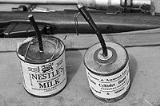
Jam Tin Grenade
Encyclopedia
The Double Cylinder, No 8 and No 9 hand grenade
s, also known as the "Jam Tin", were early designs used by the British Army
in World War I
.
The Double Cylinder was one of the many grenades designed for British use in the early part of the First World War in response to the failings of the No 1 grenade
.
The grenade was an inner can of explosive with an outer can of metal fragments or ball bearings. The heavier pattern No 9 grenade contained more high explosive and more metal fragments.
The fuse was ignited by a friction device or a cigarette.
Initially when demand for grenades was at its greatest, engineers were encouraged to improvise their own grenades from the tins containing the soldier's ration of jam, hence the name. Incidents with the improvised form and the supply of superior grenades led to official withdrawal of the design.
Hand grenade
A hand grenade is any small bomb that can be thrown by hand. Hand grenades are classified into three categories, explosive grenades, chemical and gas grenades. Explosive grenades are the most commonly used in modern warfare, and are designed to detonate after impact or after a set amount of time...
s, also known as the "Jam Tin", were early designs used by the British Army
United Kingdom
The United Kingdom of Great Britain and Northern IrelandIn the United Kingdom and Dependencies, other languages have been officially recognised as legitimate autochthonous languages under the European Charter for Regional or Minority Languages...
in World War I
World War I
World War I , which was predominantly called the World War or the Great War from its occurrence until 1939, and the First World War or World War I thereafter, was a major war centred in Europe that began on 28 July 1914 and lasted until 11 November 1918...
.
The Double Cylinder was one of the many grenades designed for British use in the early part of the First World War in response to the failings of the No 1 grenade
No 1 Grenade
The Grenade, Hand No 1 was the first British hand grenade used in World War I.-Overview:The Grenade No 1 was designed in the Royal Laboratory and is based on reports of Japanese hand grenades during the Russo-Japanese War by General Sir Aylmer Haldane, who was a British observer of the...
.
The grenade was an inner can of explosive with an outer can of metal fragments or ball bearings. The heavier pattern No 9 grenade contained more high explosive and more metal fragments.
The fuse was ignited by a friction device or a cigarette.
Initially when demand for grenades was at its greatest, engineers were encouraged to improvise their own grenades from the tins containing the soldier's ration of jam, hence the name. Incidents with the improvised form and the supply of superior grenades led to official withdrawal of the design.

